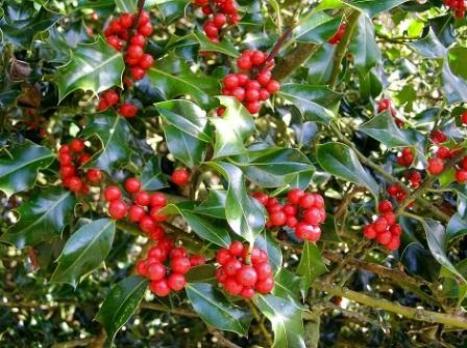
Holly Berries
December’s “Nature’s Calendar” is bringing this monthly series to an end. Since January, each article has focused on a different habitat and landscape, highlighting many of Donegal’s best wild places, and some of our most special wildlife. But getting close to Nature is also about discovering what is right on your own doorstep. Gardens can be vital wildlife reserves all year round, and especially valuable during a big freeze.
Berry bushes such as Cotoneaster are a great food-store for birds, especially members of the Thrush family, and it’s always worth keeping a eye out for flocks of Waxwings. These winter visitors from Northern Europe appear every few years, nearly always seen in small flocks around towns and cities. One of the best trees for attracting winter birds is the Alder, for its small cone-like fruits are packed with tiny seeds which are ideal for Tits and Finches. Alder trees grow remarkably fast, and are not too big for most gardens. Stacks of logs, or piles of leaves and clippings, can provide shelter for a huge variety of mini-beasts, and hibernating sites for Hedgehogs. Given time, a log pile of different timbers can produce a lovely variety of mosses, lichens and fungi.
For real close-up and armchair birdwatching, you need to provide a well-positioned feeding station. There’s a big variety now of bird-table and feeder designs, and all sorts of commercial bird food, but even a single peanut feeder can give great entertainment. Most of the visitors to your hanging feeders will be the colourful Tits and Finches. Great Tits, Blue Tits and Coal Tits are very common in gardens, while the Long-tailed Tit tends to appear only in the hardest weather. Chaffinches, Goldfinches, and smaller numbers of Greenfinches are also very regular, and the little Siskin is getting much more frequent in recent years. House Sparrows are very familiar in town gardens. The shower of scraps from the feeder doesn’t go to waste, for the ground-feeding birds are waiting underneath – Robins, Dunnocks, Thrushes and Blackbirds. Windfall apples are also much appreciated. Any bird food that you supply on the ground should be in small enough quantities to be used up each day.
Holly and Ivy have played a big part in Winter Solstice decorations and ceremonies since long before the coming of Christianity, and those shiny evergreen leaves have been providing vital shelter for bird and insect life since long before humans came on the scene at all. Holly trees are either male or female, and only the females produce the red berries. Sadly, in many places female trees have been hacked to bits for the Christmas market and have become very scarce. So it’s a good idea to have a couple of Holly bushes in the garden, so that you can trim off enough for your decorations each year without plundering the countryside.
Ivy’s unusual time of flowering makes it one of our most valuable wild plants. The sprays of greenish-yellow florets are at their peak between October and December, and this late delivery of nectar and pollen is a lifeline for many insects, such as hoverflies and bees. In a month or two, the flowers will be developing into small dark berries, well after most other berries have been used up, so these are a vital standby for many birds, especially Thrushes, Blackbirds and Starlings.
Hunting and killing the tiny Wren is completely illegal nowadays, but this ancient ritual is still celebrated on St. Stephen’s Day with imitation Wrens in parts of the country. It’s a strange remnant of our ancestors’ belief in blood sacrifice. The Wren is not the smallest Irish bird (that honour belongs to the Goldcrest) but the cocky angle of the Wren’s tail qualifies it as the shortest. All across Europe it appears in folk tales as a character with a lot of wit and cunning, and it seems as if it has always attracted plenty of attention, in spite of its rather secretive lifestyle. It does have an amazingly loud and complicated song for such a small body.
Wrens are common in most habitats, including gardens, but you will never see one on your hanging feeder, and rarely on the bird table. They prefer to hunt on the ground under dense foliage, and can even keep going in the spaces under a thick layer of snow. Huge numbers die during severe frost, but with clutches of up to a dozen eggs, and two or three broods, they soon make up their numbers the following summer. They’re famous for their communal roosts on winter nights in some cosy nook, with often over a dozen piling in together, heads to the centre and tails pointing out.
Four to Find this Month:Robin Singing: Birds sing to defend their territory, and as the Robin is one of the few to hold territory through the winter, it is the song that you’re most likely to hear around the garden at this time of year. |